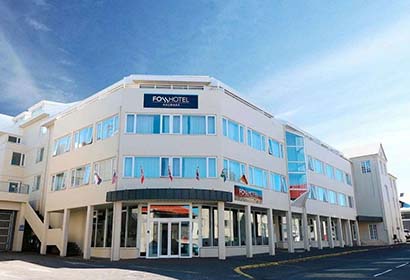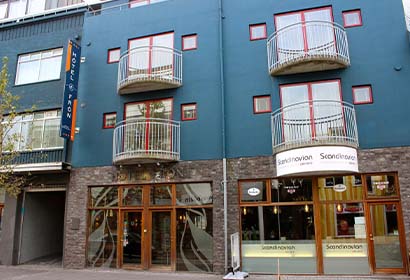Featured Holidays January
11.8°C
Today (19-06-2025)
DEALS
HIGHLIGHTS

Iceland, often referred to as the "Land of Fire and Ice," is a place where extremes coexist in breathtaking harmony. Imagine standing before the powerful Skógafoss waterfall, feeling the mist on your face, or hiking across the otherworldly landscapes of Þórsmörk Valley. The Golden Circle route, encompassing Þingvellir National Park, Geysir Hot Springs, and Gullfoss waterfall, offers a compact introduction to the country’s natural wonders. For a truly immersive experience, venture to the remote Westfjords, where dramatic fjords and untouched wilderness provide a sanctuary for rare wildlife and offer an unparalleled sense of isolation.
SEASONS TO TRAVEL
January
Hottest: 2°C Temperature
Coldest: -6°C Temperature
Average: -2°C Temperature
March
Hottest: 5°C Temperature
Coldest: -5°C Temperature
Average: 0°C Temperature
December
Hottest: 3°C Temperature
Coldest: -3°C Temperature
Average: -1°C Temperature
November
Hottest: 4°C Temperature
Coldest: -1°C Temperature
Average: 1°C Temperature

Iceland’s unique beauty is best experienced across its varied seasons, each offering distinct advantages. Winter (December to February) is a magical time, renowned for the ethereal Northern Lights, which are best seen away from city lights. The landscape is blanketed in snow, creating a picturesque winter wonderland perfect for ice caving and exploring frozen waterfalls. Spring (March to May)ushers in the return of migrating birds and the blossoming of wildflowers. The milder weather makes it an excellent time for hiking and enjoying Iceland’s diverse flora and fauna as the landscape begins to thaw. Summer (June to August), with its Midnight Sun, provides extended daylight hours ideal for exploring Iceland’s stunning natural wonders like geysers, waterfalls, and glaciers, and engaging in activities like whale watching and glacier hiking. Autumn (September to November) offers a serene experience with fewer crowds and vibrant fall colors.
CULTURE & TRADITIONS

Icelandic culture is a unique blend of ancient traditions and modern innovation. Rooted in Viking history, the Icelandic sagas are epic tales that have shaped the national identity and continue to influence contemporary literature and art. Festivals play a significant role in Icelandic life, from the vibrant Reykjavik Culture Night to the traditional Þorrablót midwinter feast, where locals gather to enjoy traditional foods and celebrate their heritage. Icelanders also have a deep connection to nature, with folklore rich in elves, trolls, and hidden people believed to inhabit the landscape. This respect for the environment is reflected in their sustainable living practices and a strong emphasis on renewable energy.
PREFFERED HOTELS
NATURE & WORTH A VISIT EXPERIENCE
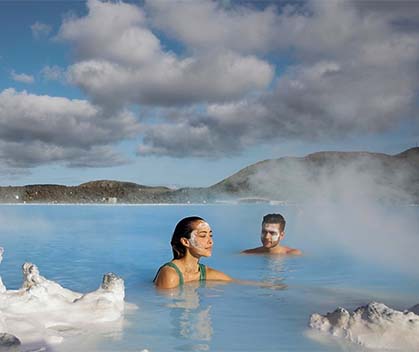
Blue Lagoon
The Blue Lagoon is an iconic geothermal spa located about 50 kilometers southwest of Reykjavik, near the town of Grindavík. Created by the runoff water from a nearby geothermal power plant, the lagoon’s waters are rich in minerals such as silica and sulfur, which contribute to their distinctive blue color and reputed healing properties. The spa’s lagoon is surrounded by a dramatic landscape of black lava fields and moss-covered rocks, creating a stark yet beautiful contrast. Visitors can indulge in a range of spa treatments, including silica mud masks and massages, and enjoy amenities such as a swim-up bar and relaxation areas. The Blue Lagoon is not just a spa but also a striking natural phenomenon that offers a unique and rejuvenating experience against a stunning backdrop.
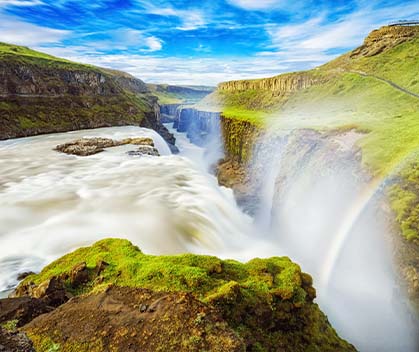
Gullfoss Waterfall
Gullfoss Waterfall, often referred to as the "Golden Falls," is a majestic and awe-inspiring feature of the Golden Circle, located in southwestern Iceland. The waterfall cascades in two stages; the upper section drops 11 meters, while the lower section plunges 21 meters into a deep, rugged canyon. The immense power and beauty of Gullfoss can be appreciated from various viewpoints along well-maintained paths. The surrounding landscape, with its volcanic formations and lush greenery, adds to the waterfall’s grandeur. On sunny days, the mist from the falls creates stunning rainbows, providing excellent photo opportunities. Gullfoss is not only a natural marvel but also a symbol of Iceland’s commitment to preserving its unique landscapes, as it was saved from being harnessed for hydroelectric power in the 20th century.

Þingvellir National Park
The park is situated in a rift valley where the North American and Eurasian tectonic plates are pulling apart, creating dramatic geological features such as fissures, rifts, and volcanic formations. Historically, Þingvellir is renowned as the site of the Alþingi, Iceland’s national parliament, which was established in 930 AD and convened annually until 1798. Visitors can explore the Almannagjá gorge, walk along the tectonic rift, and marvel at the crystal-clear waters of Þingvallavatn Lake, which is one of the largest natural lakes in Iceland. The park also offers excellent opportunities for hiking and diving, particularly in the Silfra fissure, where divers can experience visibility of up to 100 meters in the clear waters between the tectonic plates.
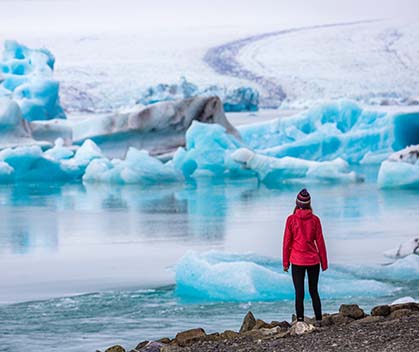
Jökulsárlón Glacier Lagoon
The lagoon was formed by the melting of the Vatnajökull glacier, one of Europe’s largest ice caps. Icebergs calved from the glacier float serenely in the lagoon before drifting out to sea. The lagoon’s deep blue waters and the massive, sculptural icebergs create an otherworldly landscape that is both tranquil and awe-inspiring. Boat tours allow visitors to navigate close to the icebergs, providing an intimate view of their intricate textures and colors. The nearby Diamond Beach, where icebergs that have drifted out to sea wash up on the black sand shore, offers a dramatic and picturesque scene, making Jökulsárlón a photographer’s paradise and a must-visit destination for nature lovers.
FOOD PARADISE
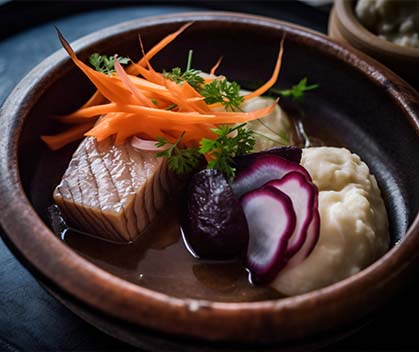
Hákarl
Hákarl is a traditional Icelandic delicacy that embodies the island’s unique culinary heritage. It consists of fermented shark meat, specifically Greenland shark, which has been buried and allowed to ferment for several months before being hung to dry. The fermentation process gives hákarl its distinctive strong aroma and flavor, which can be described as pungent and acquired. The meat is typically cut into small cubes and enjoyed with a shot of Brennivín, a local schnapps. Despite its challenging taste, hákarl is a revered part of Icelandic culture and is often sampled by visitors seeking to experience authentic Icelandic cuisine. Its preparation method reflects ancient preservation techniques that were essential for surviving harsh Arctic conditions.

Pylsur
Pylsur, Icelandic hot dogs, are a popular and beloved street food in Reykjavik and throughout Iceland. These hot dogs are made from a blend of lamb, beef, and pork, resulting in a unique and flavorful sausage with a distinctive taste. Pylsur is usually served in a soft bun and topped with a variety of condiments, including ketchup, mustard, remoulade (a tangy sauce made with mayo and relish), and crispy onions. The traditional way to enjoy a pylsur is to add raw onions and fried onions, along with a drizzle of sweet and tangy mustard. Often, it’s accompanied by a generous dollop of remoulade. Pylsur is not just a quick snack but a cultural icon in Iceland, reflecting the country’s love for simple yet delicious comfort food.
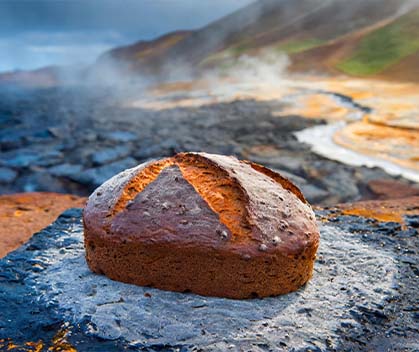
Rúgbrauð
Made primarily from rye flour, the bread has a subtly sweet flavor, often enhanced with ingredients like molasses or syrup. Its preparation is unique, traditionally involving baking in a geothermal oven or in a pot, which uses Iceland's abundant natural heat sources. This method not only gives the bread its characteristic moist crumb but also infuses it with a subtle earthy flavor. Rúgbrauð is traditionally served with a variety of toppings, such as creamy butter, smoked salmon, or rich pâté, making it a versatile accompaniment to many Icelandic dishes. Its hearty, robust flavor complements a range of foods and reflects Iceland's innovative approach to utilizing its natural resources. Rúgbrauð embodies the essence of Icelandic home cooking, providing warmth and satisfaction in every slice.

Kjötsúpa
Kjötsúpa, is a cherished traditional dish renowned for its hearty and comforting qualities. This rich stew features tender chunks of lamb or beef, simmered slowly with a variety of root vegetables like potatoes, carrots, and rutabaga. The soup’s robust flavor comes from a savory broth seasoned with herbs such as thyme and bay leaf, enhancing the natural taste of the meat and vegetables. Kjötsúpa is particularly favored during the colder months, providing a nourishing meal that warms from the inside out. Its simplicity and wholesome ingredients highlight the traditional Icelandic emphasis on using local produce and straightforward cooking methods. Often enjoyed as a communal meal, kjötsúpa is a perfect example of Icelandic culinary traditions, offering both comfort and a taste of the island's rich gastronomic heritage.


